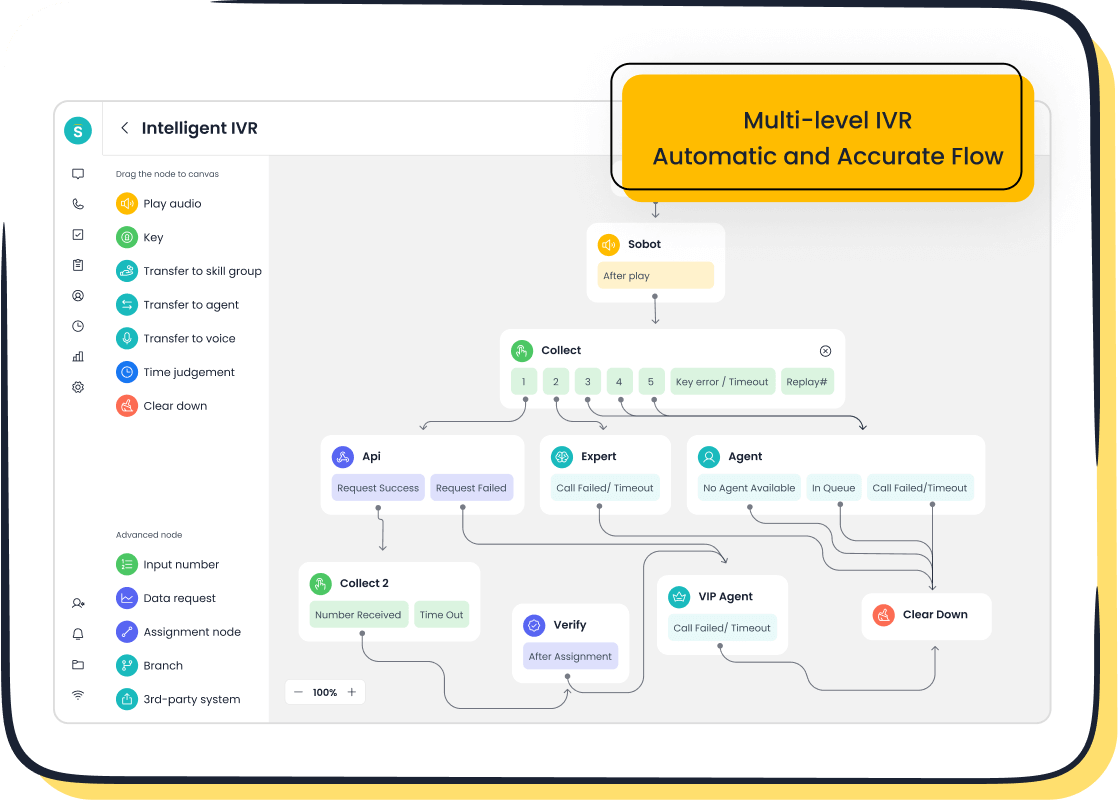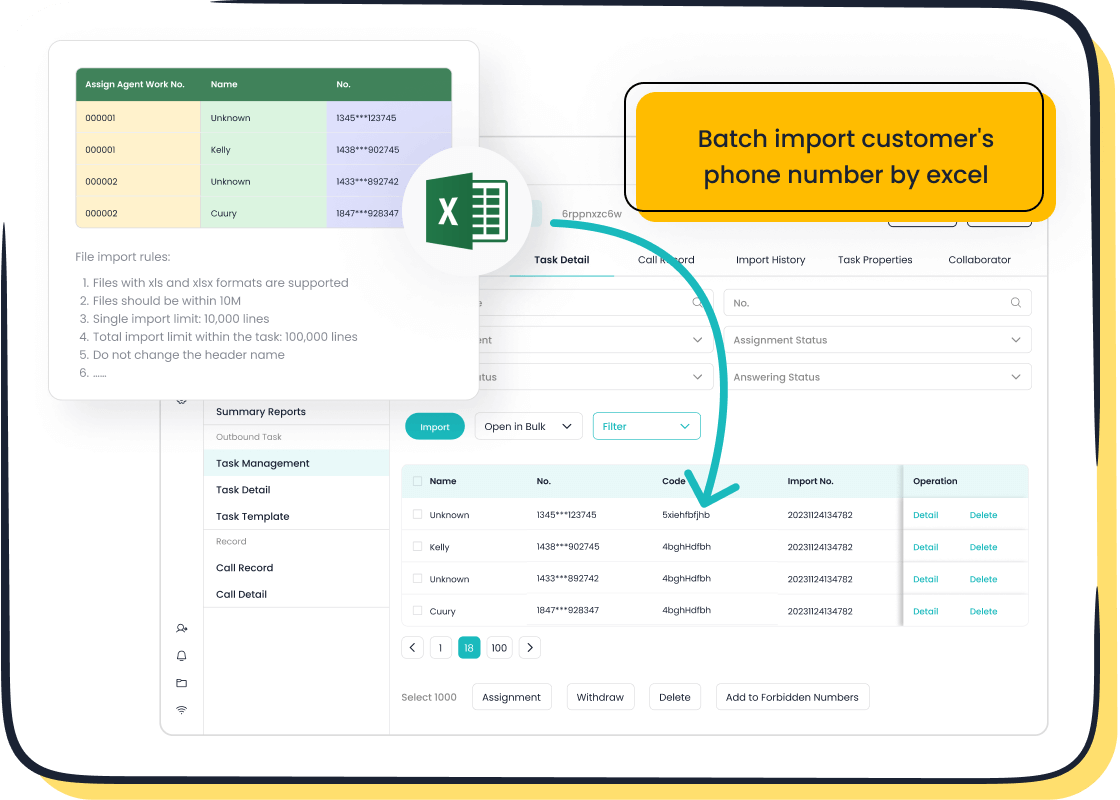How to Measure and Analyze Service Attitude Complaint Rate

Service attitude complaint rate (SACR) measures how often customers report dissatisfaction with the behavior or attitude of service staff. It reflects the quality of interactions between your team and customers. A high SACR often signals deeper issues, such as inadequate training or poor communication skills.

Understanding SACR helps you identify gaps in customer service. For example, a study by PwC found that 32% of customers stop doing business with a brand after one bad experience. Tools like Sobot's Voice/Call Center can help you track SACR effectively, ensuring you address complaints promptly and improve customer satisfaction.
Understanding Service Attitude Complaint Rate (SACR)
Definition and Importance of SACR
What SACR measures and why it matters for customer service.
SACR measures how often customers report dissatisfaction with the attitude or behavior of your service team. It focuses on the human aspect of customer interactions, such as politeness, empathy, and professionalism. This metric helps you understand how well your team meets customer expectations during interactions.

When SACR is high, it signals potential gaps in training or communication. For example, if customers frequently complain about rude or unhelpful agents, it reflects poorly on your brand. Tracking SACR allows you to identify these issues early and take corrective action. Tools like Sobot's Voice/Call Center simplify this process by providing real-time call tracking and sentiment analysis.
Impact of SACR on customer satisfaction and retention.
SACR directly impacts customer satisfaction and retention. Customers who experience poor service attitudes are less likely to return. Studies show that 33% of Americans consider switching companies after just one bad service experience. A low SACR improves your customer satisfaction score and builds loyalty. By addressing complaints effectively, you can enhance satisfaction and reduce churn.
Common Standards for SACR
Industry benchmarks for acceptable SACR levels.
Acceptable SACR levels vary by industry, but most aim for less than 5%. High-performing companies often achieve rates below 2%. These benchmarks help you set realistic goals for your team. Using Sobot's analytics tools, you can compare your SACR against industry standards and identify areas for improvement.
Examples of service attitude issues affecting SACR.
Service attitude issues include rudeness, lack of empathy, and poor communication. For instance, 36% of young customers report frustration with poorly trained agents. Additionally, 27% of U.S. consumers cite difficulty reaching a live agent as a major issue. These problems significantly increase SACR.
| Statistic | Source |
|---|---|
| 1/3 of consumers would consider switching companies after a single instance of bad customer service. | American Express, 2017 |
| 58% of US customers have left a brand because of poor service. | Microsoft, 2019 |
| 63% of American consumers have switched brands due to bad customer service. | Microsoft, 2019 |

Measuring SACR Effectively
Data Collection Methods
Using customer feedback channels like surveys and reviews.
Collecting customer feedback is essential for accurately measuring service attitude complaint rate (SACR). Surveys and reviews provide direct insights into customer experiences, preferences, and satisfaction levels. By asking specific questions, you can gather the necessary data to identify areas for improvement. For instance:
- Surveys allow you to measure customer satisfaction and pinpoint service issues.
- Short, straightforward questions, such as "How satisfied were you with the agent's attitude?" yield valuable insights.
- Reviews help you understand recurring complaints and trends.
To maximize effectiveness, keep surveys concise and easy to answer. This approach ensures higher response rates and more actionable data. Leveraging customer feedback channels helps you track customer service metrics and improve service delivery.

Leveraging Sobot's Voice/Call Center for call tracking and analysis.
Sobot's Voice/Call Center simplifies SACR measurement by offering advanced call tracking and analysis features. It enables you to monitor customer interactions in real time, identify complaints, and analyze patterns. The platform's intelligent IVR system and AI-powered voicebot enhance data collection by capturing customer sentiment during calls. With these tools, you can efficiently manage customer service metrics and address service-related complaints.
Tools for SACR Measurement
AI-powered sentiment analysis tools for customer interactions.
AI-powered sentiment analysis tools are revolutionizing how businesses measure SACR. These tools analyze customer interactions to detect emotions and attitudes. For example:
- T-Mobile reduced customer complaints by 73% by using sentiment analysis to address common issues.
- Ford improved customer satisfaction by identifying trends in feedback through AI.
By integrating sentiment analysis into your customer service metrics, you can proactively resolve issues and enhance customer satisfaction.
Sobot's unified workspace for managing SACR-related data.
Sobot's unified workspace consolidates all SACR-related data into a single platform. This feature allows you to manage customer interactions, complaints, and feedback seamlessly. The workspace integrates data from multiple channels, providing a comprehensive view of your service performance. With Sobot, you can track customer service metrics efficiently and make data-driven decisions to improve SACR.
Calculating SACR
Formula for SACR: (Number of complaints about service attitude / Total customer interactions) x 100.
Calculating SACR involves dividing the number of complaints about service attitude by the total customer interactions, then multiplying by 100. For example, if you receive 50 complaints out of 5,000 interactions, your SACR is 1%. This formula helps you quantify service performance and identify areas needing improvement.
Setting benchmarks for SACR using Sobot's analytics tools.
Sobot's analytics tools help you set realistic SACR benchmarks by comparing your performance against industry standards. High-performing companies often maintain SACR below 2%. With Sobot, you can track your progress and implement strategies to meet or exceed these benchmarks, ensuring better service quality and customer satisfaction.
Analyzing SACR Data for Actionable Insights
Identifying Trends and Patterns
Tracking SACR over time to spot recurring issues.

Tracking SACR over time helps you identify recurring issues in customer interactions. By monitoring trends, you can pinpoint periods when complaints spike and investigate the causes. For instance, seasonal demand surges or new product launches may lead to higher complaint rates. Using tools like Sobot's Voice/Call Center, you can analyze historical data and detect patterns in customer dissatisfaction. This proactive approach allows you to address issues before they escalate, improving your overall service quality.
Comparing SACR across different customer service channels.
Comparing SACR across channels, such as phone, email, and live chat, reveals which platforms face the most challenges. For example, a higher SACR in voice calls might indicate a need for better agent training or improved call routing. Sobot's unified workspace consolidates data from all channels, making it easier to compare performance. This comprehensive view helps you allocate resources effectively and enhance customer experiences across all touchpoints.
Root Cause Analysis
Categorizing complaints to identify common themes.
Categorizing complaints is essential for understanding the root causes of dissatisfaction. Grouping feedback into themes, such as agent behavior or response time, highlights areas needing improvement. Research shows that emotional responses like frustration often drive complaints. By coding and categorizing feedback, you can uncover customer pain points and expectations. Sobot's Voice/Call Center simplifies this process by providing detailed call data and sentiment analysis, enabling you to develop targeted solutions.
Using Sobot's Voice/Call Center data for deeper analysis.
Sobot's Voice/Call Center offers advanced tools for analyzing customer service metrics. Real-time call tracking and AI-powered sentiment analysis help you dive deeper into complaint data. For example, you can identify whether complaints stem from agent tone, call duration, or unresolved issues. This granular analysis equips you with actionable insights to refine your service strategies and reduce SACR.
Extracting Insights for Improvement
Prioritizing issues based on frequency and impact.
Prioritizing issues ensures you focus on the most critical problems. Metrics like average issue count and resolution rate help you determine which complaints occur most often and have the greatest impact. For example:
| Metric | Description |
|---|---|
| Average Issue Count | Tracks the number of cases over a specific period to identify frequent issues. |
| Resolution Rate | Measures the percentage of successfully resolved issues, reflecting the effectiveness of your team. |
By addressing high-frequency, high-impact issues first, you can make meaningful improvements to your service.
Aligning SACR insights with business goals.
Aligning SACR insights with your business goals ensures your strategies drive measurable outcomes. For example, reducing SACR can directly improve customer satisfaction and retention, which supports revenue growth. Sobot's analytics tools help you connect SACR data with broader customer service metrics, enabling you to track progress and achieve your objectives. This alignment ensures your efforts contribute to both customer happiness and business success.
Strategies to Improve SACR
Training and Development
Providing soft skills training for customer service teams.
Soft skills training equips your team with the tools to handle interactions professionally. Focus on skills like empathy, active listening, and clear communication. For example, training programs that emphasize emotional intelligence can help agents better understand customer frustrations. This approach reduces complaints and improves customer service performance. Companies that invest in soft skills training often see a significant drop in service attitude complaints, as agents become more adept at managing challenging situations.
Role-playing exercises to handle challenging situations.
Role-playing exercises simulate real-life scenarios, allowing your team to practice handling difficult interactions. For instance, you can create scenarios where customers express dissatisfaction with a product or service. By practicing responses, agents gain confidence and learn to de-escalate tense situations. These exercises also help identify gaps in your team's approach, enabling targeted improvements. Regular role-playing sessions ensure your team is prepared to deliver exceptional service, even under pressure.
Process Optimization
Streamlining workflows using Sobot's Voice/Call Center features.
Streamlined workflows enhance efficiency and reduce errors. Sobot's Voice/Call Center offers tools like intelligent IVR and smart call routing to optimize processes. These features ensure customers reach the right agent quickly, minimizing frustration. Improved workflows also boost key performance indicators like service level, first call resolution, and overall resolution rate. For example:
| KPI | Description |
|---|---|
| Service Level | Measures the percentage of calls answered within a specific time frame, indicating responsiveness. |
| First Call Resolution | Indicates the percentage of issues resolved on the first contact, directly impacting customer satisfaction. |
| Resolution Rate | Reflects the percentage of customer issues successfully resolved, showcasing service effectiveness. |
Efficient workflows not only improve customer service performance but also enhance the overall customer experience.
Implementing clear escalation protocols for complex issues.
Clear escalation protocols ensure complex issues are resolved efficiently. Define steps for escalating unresolved problems to higher-level agents or managers. For example, if an agent cannot resolve a complaint within a set timeframe, the system should automatically route the issue to a supervisor. Sobot's unified workspace simplifies this process by integrating escalation protocols into its platform. This approach reduces delays and ensures customers receive timely resolutions, improving satisfaction.
Feedback Loops
Encouraging real-time customer feedback.
Real-time customer feedback provides immediate insights into service quality. Use tools like post-call surveys or live chat ratings to gather feedback after each interaction. For example, ask customers to rate their experience on a scale of 1 to 5. This data helps you identify areas for improvement and track progress over time. Encouraging customer feedback also shows customers that you value their opinions, fostering trust and loyalty.
Using employee feedback to identify internal challenges.
Employee feedback is equally important for improving customer service performance. Regularly ask your team about challenges they face during interactions. For instance, agents might highlight issues with outdated scripts or insufficient training. Addressing these concerns improves their ability to resolve customer issues effectively. Sobot's Voice/Call Center supports this by providing detailed call analytics, helping you align employee feedback with actionable solutions.
Continuous Monitoring and Improvement
Regular SACR Reviews
Setting up periodic reviews to track progress.
Regular reviews of your service attitude complaint rate (SACR) help you track progress and maintain high service standards. Set up monthly or quarterly reviews to analyze SACR trends and identify areas for improvement. For example, if you notice a spike in complaints during peak seasons, you can prepare your team with additional training or resources. Sobot's Voice/Call Center simplifies this process by providing real-time data and historical trends, enabling you to conduct efficient reviews. These periodic evaluations ensure you stay proactive in addressing customer concerns.
Adjusting strategies based on updated SACR data.
Use updated SACR data to refine your strategies and improve service quality. For instance, if complaints about agent behavior increase, focus on soft skills training or adjust call scripts. Sobot's analytics tools allow you to segment data by channel, time, or issue type, helping you pinpoint specific problems. By acting on these insights, you can reduce complaints and enhance the overall customer experience. Regular adjustments based on data ensure your service evolves to meet customer expectations.
Leveraging Technology for Monitoring
Using Sobot's analytics tools for automated SACR tracking.
Automated tools make SACR tracking more efficient and accurate. Sobot's analytics platform integrates advanced features like sentiment analysis and call tracking to monitor customer interactions in real time. These tools identify patterns in complaints and provide actionable insights. For example, sentiment analysis can detect negative emotions in calls, allowing you to address issues before they escalate. The table below highlights the benefits of using advanced analytics for SACR tracking:
| Evidence Type | Description |
|---|---|
| Customer Data Analytics | Automatic loading of ecommerce data helps track metrics like site traffic and conversion rates. |
| Social Media Accounts | Provides customer sentiment analysis to assess marketing success and identify customer needs. |
| Customer Analytics Benefits | Up to 20% higher CSAT due to proactive problem resolution and better understanding of customer journeys. |
By leveraging these tools, you can improve customer satisfaction and streamline your monitoring processes.
Integrating SACR insights into broader customer experience metrics.
SACR insights play a crucial role in shaping your overall customer experience strategy. Integrate these insights with other metrics like Net Promoter Score (NPS) or Customer Satisfaction Score (CSAT) to get a comprehensive view of your service performance. Sobot's unified workspace consolidates data from multiple channels, making it easier to align SACR trends with broader goals. For example, if SACR data reveals frequent complaints about response times, you can adjust workflows to improve efficiency. This holistic approach ensures your strategies address all aspects of the customer journey.
Service Attitude Complaint Rate (SACR) plays a vital role in improving customer service quality. By consistently measuring and analyzing SACR, you can uncover critical insights that enhance service delivery. For example, analyzing customer feedback regularly helps identify recurring issues and prioritize solutions. Addressing complaints effectively not only improves satisfaction but also builds loyalty.
To reduce SACR, focus on actionable strategies like tracking trends, implementing changes, and following up with customers after resolving complaints. Tools like Sobot's Voice/Call Center simplify this process by offering real-time analytics and sentiment analysis. These features empower you to monitor performance and make data-driven improvements. Adopting such tools ensures your business delivers exceptional service, fostering long-term customer relationships.
FAQ
What is the ideal SACR for excellent customer service?
Aim for an SACR below 2%. High-performing companies often maintain this level to ensure customer satisfaction. For example, businesses using tools like Sobot's Voice/Call Center achieve lower SACR by addressing complaints promptly and improving customer interactions.
How can SACR impact customer support performance?
A high SACR indicates gaps in customer support performance. It reflects issues like poor communication or lack of empathy. Addressing these complaints improves satisfaction and retention. Tools like Sobot's analytics help you monitor SACR and enhance service quality.
What tools can help track SACR effectively?
AI-powered platforms like Sobot's Voice/Call Center simplify SACR tracking. Features like sentiment analysis and real-time call monitoring provide actionable insights. These tools help you identify trends, address complaints, and improve service delivery.
How often should you review SACR data?
Review SACR data monthly or quarterly. Regular reviews help you spot trends and adjust strategies. For instance, Sobot's analytics tools allow you to track SACR over time and implement improvements based on updated data.
Can SACR insights align with business goals?
Yes, SACR insights directly support business goals like customer retention and revenue growth. For example, reducing SACR improves satisfaction, which boosts loyalty. Sobot's unified workspace integrates SACR data with broader metrics, ensuring alignment with your objectives.
See Also
Essential Software for Ensuring Call Center Quality Assurance
Effective Strategies for Managing Call Center Quality
Understanding Quality Management Systems in Call Centers